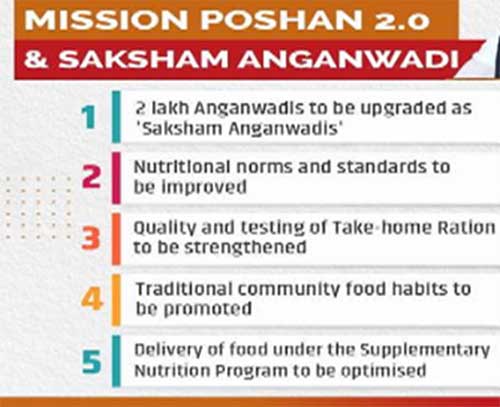Date : 13/06/2023
Relevance : GS Paper 2 : Health and Nutrition
Key Words: Life cycle Approach, Demographic Devidend, Poshan 2.0, Social and Behavior Change Communication (SBCC)
Context -
- Adolescent girl nutrition plays a crucial role in unlocking India's full potential. The period of adolescence is a pivotal stage of cognitive development, and providing adequate nutrition during this "second window of opportunity for growth" compensates for any nutrient deficiencies acquired during earlier developmental stages.
- Additionally, the health of adolescent girls is a significant indicator of women's long-term participation in India's labor force, as better nutrition enhances their prospects for engaging in productive activities.
- Thus, investing in nutrition interventions for adolescent girls presents a tremendous opportunity to contribute to India's demographic dividend.
Growing Nutritional Concerns
- Adolescent girls are particularly vulnerable to undernutrition and anaemia, primarily due to the onset of menstruation.
- Alarming statistics from the National Family Health Survey-5 (2019-21) reveal that 59.1% of adolescent girls in India suffer from anaemia.
- Furthermore, the NFHS-4 data reported that over 41.9% of school-going girls are underweight, indicating a worrying trend.
- Various factors, including environmental conditions and cultural norms that lack a gender-neutral environment within households, contribute to the inadequate nutrition uptake among adolescent girls.
Consequences of Neglecting Adolescent Girl Nutrition
- Neglecting the nutritional needs of adolescent girls can have profound consequences. Poorly balanced and insufficient diets can lead to cognitive impairments that affect academic performance.
- Lower educational attainment subsequently limits employment and economic self-sufficiency opportunities later in life.
- Moreover, undernourished adolescent girls face higher risks of chronic diseases and pregnancy complications, resulting in a greater healthcare burden on families and communities. These factors can lead to financial instability and increased poverty.
- When girls are less healthy and less educated, their ability to fully participate in society, whether through work, politics, or community involvement, is diminished.
Redefining Interventions
- It is imperative to redefine interventions that focus not only on nutrition but also adopt a life-cycle approach and Ensuring Inclusion.
- This approach ensures that no adolescent girl is left behind, leading to improved health outcomes and breaking the intergenerational cycle of poverty.
- Investing in the nutrition of adolescent girls becomes both a moral obligation and an economic imperative for the state. Well-nourished girls are more likely to have healthy babies and provide better care for their families, resulting in healthier future generations.
Strategic Modifications for Expanded Outcomes
- Convergence of Government Initiatives: Strategic modifications can significantly enhance the outcomes of existing interventions. The convergence of government initiatives, such as the Scheme for Adolescent Girls (SAG) within the umbrella of the Prime Minister's Overarching Scheme for Holistic Nutrition (POSHAN) 2.0, is a step in the right direction. Effective implementation of these initiatives is crucial to maximize their impact on adolescent girl nutrition.
POSHAN 2.0 - 7 Pillars
- ICDS- Common Aplication Software
- Training and Capacity Building
- Grievance Redressal
- Convergance
- Innovations
- Behavioural Change
- Incentives
- Strengthening Awareness and Nutrition Education Programs : Targeted adolescent-oriented schemes like the Rashtriya Kishor Swasthya Karyakram (RKSK) can include robust awareness and nutrition education programs. These initiatives will help sustain compliance among beneficiaries, promoting healthier nutritional practices among adolescent girls.
- Targeted SBCC Efforts for Demand Generation ; Regionally contextualized Social and Behavior Change Communication (SBCC) efforts can generate greater demand and adoption of good nutrition practices among adolescent girls. These targeted campaigns can address cultural norms and environmental factors that hinder nutrition uptake, fostering a positive change in behavior.
- Effective Convergence and Collaborations among Departments : To achieve improved outcomes, effective convergence and collaborations among relevant departments are essential. A collective endeavor involving health, education, and social welfare departments can optimize resources, streamline efforts, and enhance the impact of interventions.
- Routine Training of Health Workers for Implementation : Regular training of health workers is crucial to ensure the effective implementation and monitoring of various schemes. It enables them to adapt to an evolving landscape and deliver quality nutrition interventions to adolescent girls across the country.
- Using Evidence and Data : Access to disaggregated data is vital for effective interpretation and understanding of the specific challenges faced by different regions and demographics. It enables policymakers and stakeholders to tailor interventions and allocate resources more effectively.
Conclusion
Prioritizing the nutritional needs of adolescent girls is a paramount task for building a stronger India. By redefining interventions, making strategic modifications, using evidence and data, and fulfilling our roles as elected representatives, we can make a significant impact in amplifying adolescent girl nutrition. It is through collective efforts and sustained focus that we can create a healthier, stronger, and more prosperous nation where every girl can reach her full potential.
Probable Question for Mains Exam
- Question1 : Discuss the economic implications of investing in adolescent girl nutrition for India. How can prioritizing their nutrition contribute to breaking the intergenerational cycle of poverty and fostering sustainable economic growth? (10 Marks, 150 Words)
- Question 2 : Critically analyze the existing awareness and nutrition education programs targeted at adolescent girls, such as the Rashtriya Kishor Swasthya Karyakram (RKSK). Suggest measures to strengthen these programs and ensure sustained beneficiary compliance. (15 marks,250 Words)
Source - The Hindu








